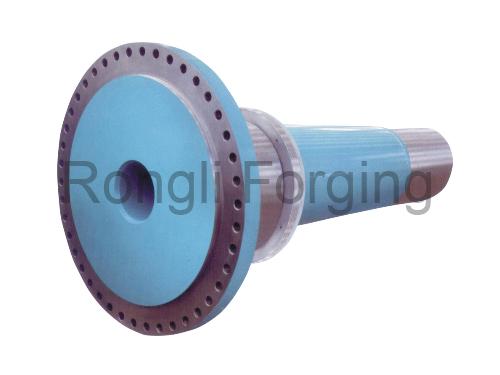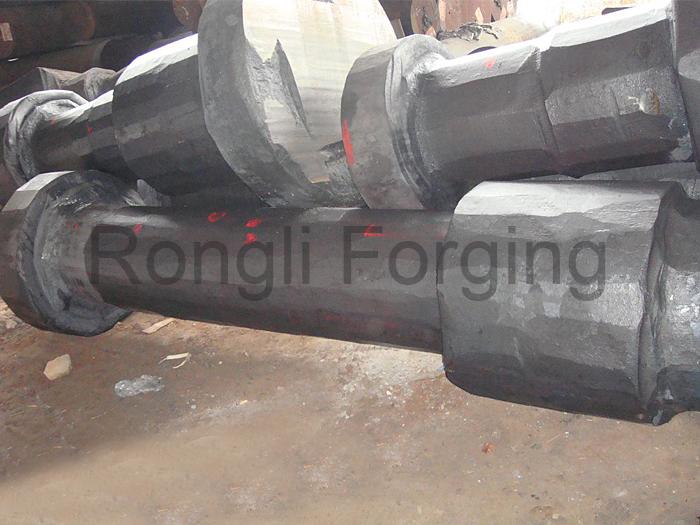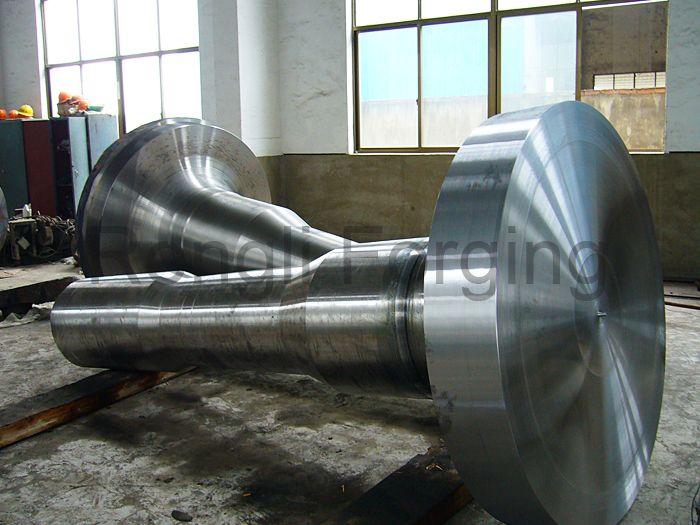
The Forging Wind Power Generator Shaft significantly boosts structural integrity. When you choose a high-quality Forging Wind Power Generator Shaft from Rongli Forging, you enhance durability and reduce maintenance costs. This process also improves energy transfer efficiency, resulting in better performance for your wind turbines. Moreover, the manufacturing method minimizes material waste, making it an eco-friendly option. Additionally, forged components contribute to the overall reliability of the system, ensuring consistent energy production. For those interested in the China Forging Wind Power Generator Shaft, Rongli Forging offers competitive Forging Wind Power Generator Shaft prices, providing a trusted solution for your wind power needs.
Key Takeaways
- Investing in forged wind power generator shafts boosts structural integrity. This leads to increased strength and a longer lifespan for your wind turbines.
- Forged shafts significantly reduce maintenance costs. Their durability means fewer repairs and lower labor expenses over time.
- Enhanced energy transfer efficiency is a key benefit of forged shafts. They minimize energy loss, resulting in higher output and better returns on investment.
- Choosing forged components helps reduce material waste. The efficient manufacturing process uses less material and promotes sustainability in the renewable energy sector.
- Forged shafts increase system reliability. Their strength and consistent performance ensure fewer failures and more dependable energy production.
Forging Wind Power Generator Shafts for Improved Structural Integrity

When you choose a forging wind power generator shaft, you invest in a component that offers superior structural integrity. Forging enhances the material’s strength and durability. This process involves shaping metal using compressive forces, which aligns the grain structure. As a result, the shaft becomes more resilient against the stresses of wind energy applications.
Here are some key benefits of improved structural integrity:
- Increased Strength: Forged shafts can withstand higher loads. This strength is crucial for the demanding conditions of wind turbines.
- Reduced Risk of Failure: A robust shaft minimizes the chances of breakage. This reliability is essential for maintaining consistent energy production.
- Longer Lifespan: With enhanced durability, forged shafts last longer. This longevity translates to fewer replacements and lower costs over time.
Tip: Always consider the quality of the forging process. High-quality manufacturing ensures that you receive a shaft that meets your specific needs.
The forging process also allows for better design flexibility. You can customize the dimensions and materials to fit various turbine models. This adaptability ensures that you get the best performance from your wind power system.
Forging Wind Power Generator Shafts to Reduce Maintenance Costs
When you invest in a forging wind power generator shaft, you significantly lower your maintenance costs. The durability of forged shafts means they can endure harsh conditions without frequent repairs. This reliability translates into fewer service interruptions and less downtime for your wind turbines.
Here are some ways forging helps reduce maintenance costs:
- Longer Lifespan: Forged shafts last longer than their non-forged counterparts. This longevity means you won’t need to replace them as often, saving you money in the long run.
- Fewer Repairs: The strength of forged shafts reduces the likelihood of damage. You can expect fewer breakdowns, which means less time and money spent on repairs.
- Lower Labor Costs: With fewer repairs needed, you can reduce labor costs associated with maintenance. Your team can focus on other important tasks instead of constant upkeep.
Tip: Regular inspections can help you catch any potential issues early. This proactive approach can further minimize maintenance costs.
By choosing a forging wind power generator shaft, you make a smart decision for your wind energy projects. The initial investment pays off through reduced maintenance expenses and increased operational efficiency. You can enjoy peace of mind knowing that your equipment is built to last.
Forging Wind Power Generator Shafts for Enhanced Energy Transfer Efficiency

When you choose a forging wind power generator shaft, you significantly improve energy transfer efficiency. The forging process aligns the metal’s grain structure, which enhances its strength. This alignment allows the shaft to transmit energy more effectively from the turbine to the generator.
Here are some key benefits of enhanced energy transfer efficiency:
- Reduced Energy Loss: Forged shafts minimize energy loss during operation. This efficiency means that more of the wind’s energy gets converted into electricity.
- Improved Performance: With better energy transfer, your wind turbines can operate at optimal levels. This performance leads to higher energy output and better returns on investment.
- Consistent Power Generation: Forged shafts help maintain steady energy production. This consistency is crucial for meeting energy demands and ensuring grid stability.
Tip: Regularly monitor the performance of your wind turbines. This practice helps you identify any issues early and ensures that your forged shafts continue to operate efficiently.
The manufacturing techniques used in forging also contribute to energy efficiency. By reducing material waste during production, you not only save resources but also lower the overall environmental impact. This commitment to sustainability aligns with the goals of the renewable energy sector.
Forging Wind Power Generator Shafts to Reduce Material Waste
When you choose forged wind power generator shafts, you actively contribute to reducing material waste. The forging process is efficient and minimizes excess material during production. This efficiency not only saves resources but also lowers costs for manufacturers and consumers alike.
Here are some key points about how forging reduces material waste:
- Efficient Material Use: Forging allows manufacturers to use only the necessary amount of material. This precision means less scrap metal ends up in landfills.
- Stronger Components: The forging process creates stronger components. Stronger shafts require less material to achieve the same performance, further reducing waste.
- Recyclable Materials: Many materials used in forging are recyclable. If a shaft reaches the end of its life, you can recycle it, minimizing environmental impact.
Tip: When selecting a supplier, consider their commitment to sustainable practices. A focus on reducing material waste reflects a responsible approach to manufacturing.
The benefits of reducing material waste extend beyond cost savings. By choosing forged shafts, you support a more sustainable manufacturing process. This commitment aligns with the growing demand for eco-friendly solutions in the renewable energy sector.
In addition, the reduced waste from forging contributes to a smaller carbon footprint. As you invest in wind power technology, you also promote environmental stewardship. This choice not only benefits your projects but also supports the planet’s health.
By prioritizing forged wind power generator shafts, you make a positive impact on both your operations and the environment. Embrace the advantages of forging and help drive the renewable energy movement forward.
Forging Wind Power Generator Shafts for Increased System Reliability
When you choose forged wind power generator shafts, you enhance the reliability of your entire wind energy system. Forging creates components that can withstand the harsh conditions of wind energy applications. This durability leads to fewer failures and more consistent performance.
Here are some key reasons why forged shafts increase system reliability:
- Stronger Materials: The forging process aligns the grain structure of the metal. This alignment results in stronger materials that resist wear and tear.
- Consistent Performance: Forged shafts maintain their integrity over time. You can expect them to perform reliably, even under extreme conditions.
- Reduced Downtime: With fewer failures, your wind turbines experience less downtime. This reliability ensures that you generate energy consistently.
Tip: Regular maintenance checks can help you identify potential issues early. This proactive approach keeps your system running smoothly.
The manufacturing techniques used in forging also contribute to reliability. High-quality forging processes ensure that each shaft meets strict standards. This attention to detail minimizes defects and enhances overall performance.
Additionally, forged shafts are designed for specific turbine models. This customization ensures a perfect fit, which further boosts reliability. When components fit well, they work together seamlessly, reducing the risk of mechanical failures.
Forging wind power generator shafts offers numerous benefits that enhance energy efficiency. You gain improved structural integrity, reduced maintenance costs, and better energy transfer. High-quality manufacturing plays a crucial role in the renewable energy sector. It ensures that components perform reliably and sustainably.
Tip: Stay informed about advancements in wind power technology. Exploring new innovations can help you make better choices for your energy projects.
By investing in forged components, you contribute to a more efficient and sustainable future in wind energy.
FAQ
What are the benefits of using forged wind power generator shafts?
Forged shafts offer improved strength, durability, and energy transfer efficiency. They reduce maintenance costs and material waste, contributing to a more reliable wind energy system.
How does forging enhance energy transfer efficiency?
The forging process aligns the metal’s grain structure, allowing for better energy transmission. This alignment minimizes energy loss, leading to higher output from your wind turbines.
Why should I choose Rongli Forging for my generator shafts?
Rongli Forging specializes in high-quality forged components. Our shafts meet international standards and undergo rigorous testing, ensuring reliability and performance for your wind energy projects.
How does forging reduce material waste?
Forging uses only the necessary amount of material, minimizing scrap. Stronger components require less material to achieve the same performance, promoting sustainability in manufacturing.
Can forged shafts be customized for different turbine models?
Yes! Forged shafts can be tailored to fit various turbine models. This customization ensures optimal performance and compatibility with your specific wind energy system.
Post time: Sep-19-2025




